Serving in Volleyball is obviously a very important part of the game as without the serve the rally would never begin.
Maybe you are a spectator of the sport or perhaps even a player and just never thought to ask just how exactly the Serving team or in fact, the serving player is determined.
Well in this article I hope to clear up all these points as well as address some common rules that you need to be wary of when serving the volleyball.
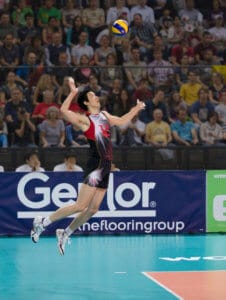
So going back to our original question.
How do we determine who is serving in volleyball?
Prior to the match commencing the referee will call in the team captains from each team, the referee will often flip a coin, the winner of the coin flip can choose to serve or receive first. Once the match has started the team that wins the rally will become the serving team.
Regarding which player should be serving from each team is determined by your lineup and rotations.
Now I get it, you are looking at the above and thinking ‘right, that makes sense but i’m still not sure exactly who is serving at what time?’
Well let’s dive into this in a bit more detail.
Table of Contents
Which Team Serves First In Volleyball
As mentioned above, before the match starts the head official will call in team captains from both teams.
During this time the referee will introduce themselves as well as the captains greeting each other, the referee will run over the core concepts of the event and also make note of any overhead obstructions or surrounding obstacles.
Here the referee will clarify what happens if the ball strikes any of these obstacles and the will also cover the general run of play.
Once the referee has clarified these points it’s time to decide who will be the serving and or receiving team.
Often this is done using the coin flip and normally the travelling team will get to call the coin flip.
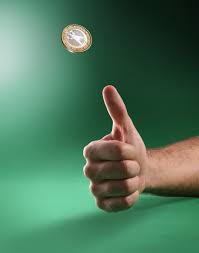
Whoever wins the coin flip is given the choice to Serve first or Receive first and this is how the serving team is determined.
Now you may be wondering why anyone would choose to receive?
Well it can actually be a very good tactic if you are confident in your passers and attackers, if you can receive the first ball and win the point, not only does your team get a nice confidence boost straight away but you also get the serve and the lead.
Next time you are given the choice, why not choose to receive and see what your opponent’s reaction is like?.
Once the first set has been played out, the team that didn’t serve in the first set will become the serving team to start the second set.
The process continues for the remaining sets with one exception.
Volleyball matches are played to 5 sets.
If both teams have 2 sets making the match tied at 2-2.
The referee will call back the captains to carry out another coin flip.
Again the winner of the coin flip will decide which team will serve or receive.
How To Determine Which Team Serves During The Match
During the match it is nice and easy to determine which team is serving.
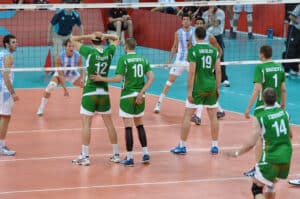
If your team is the serving team and you win the rally or the point, your team will remain the serving team.
If however, your team loses that point, the opposition will become the serving team.
That’s all there is to it.
The team that wins the point will be the next team serving.
How To Determine Which Player On The Team Is Serving
To better answer this question we first need to understand the basics of rotating positions and also we need to understand our position in the teams lineup.
every time a team wins a point from the opposition that started the rally as the serving team, we need to rotate one spot in a clockwise direction.
This means the player that was at the back right position (Also known as Position 1) will rotate clockwise one position to the middle back position (Also known as Position 6)
To better explain this I will put a diagram below showing how teams rotate round the court.
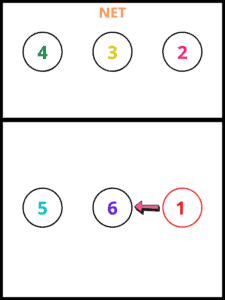
This process repeats throughout the whole game.
Now the reason I mention this is because without first understanding this it would make determining the serving player extremely difficult.
So now we know that we rotate clockwise one spot every time we win a point from the serving team. We can use this to determine who serves next on the team.
The player who is at the back right position (position 1) is the serving player for the team.
This player prior to winning the point would have been standing in the front right position (Position 2).
Once the point is won this player drops back to the back court, however, as their team just won the point they must start the next rally by serving.
Using the above we can now determine who is serving at all times.
every time we win a point from the serving team we rotate one position clockwise, the player moving to the back right location on court or position 1 is the next serving player.
If you are still unclear hopefully the below pictures will better show what I am trying to explain.
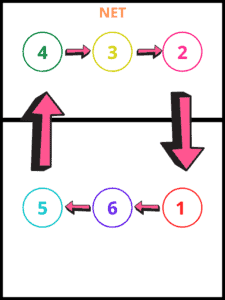
Volleyball Serving Rules You Need To Know
Where Can You Stand To Serve?
The first thing to note is where exactly you can and can’t serve from.
You must stand behind the backline of the court which is sometimes referred to as the baseline or service line.
However you may still be in the playing area, this being between the antenna’s.
What this means is that you can stand anywhere behind the baseline to serve however you can’t step to the right or left of the sidelines.

A simple way to ensure you don’t do this is to pretend the sidelines continue all the way back past the baseline.
If you serve the ball from the outside of this playing area the referee would call a fault and the other team would be awarded the point.
Do You Have To Toss The Ball?
Regardless of serving technique it is a rule that the ball must be tossed in some way, shape or form before the ball can be served.
When Are You Allowed To Serve?
Before you are allowed to serve you must wait for the referee to blow their whistle and do the arm motion that indicates you have permission to serve.
The referee will show this by using their arm which is on the same side as you serving and carrying it upwards and across their body, the motion will almost mimic the flight path of the ball when serving.

For more detailed information of official hand signals check out this article here: Official Hand Signals.
Once the referee has signalled you are clear to serve, you have 8 seconds to contact the ball.
If you do not contact the ball within 8 seconds a ‘delay of play’ fault will be called and the other team will be awarded the point.
Can You Start Your Serve Again If You Toss The Ball Wrong?
It’s actually surprising that even many experienced players don’t know that you actually can restart your serve.
However, there is actually quite a specific criteria that must be met in order to restart your serve.
Now you can’t just smash a jump serve out of bounds and ask for a do-over, it definitely doesn’t work like that.
Even though that would be lovely, just keep cranking jump serves until you get one in.
You can actually only restart your serve providing you haven’t contacted the ball.
What I mean by this, is if you toss the ball up and you aren’t happy with it, you can’t touch or catch the ball. If you do this, it will be considered part of the serve and therefore would be a service fault if the ball doesn’t travel over the net.
If we go back to this example and change just one thing, you can actually restart your serve.
So if you toss the ball and you aren’t happy with the toss, if you step back from the tossed ball and allow it to bounce on the ground without touching it, you can actually restart your serve.
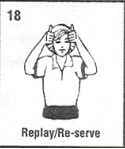
However this reset’s the whole play, this means before starting your second attempt you must wait for the official to signal the service again.
What Is A Foot Fault When Serving In Volleyball?
The last common fault when serving is known as the foot fault.
The foot fault is a nice easy one to avoid and an easy one to understand.
If you can cast your mind back to when I was talking about the baselines which are sometimes referred to as the service line.
When serving you are not allowed to touch or step on this line when serving.
This means you must stand behind the line when serving and make sure you don’t come into contact with it throughout the serving process.
I have seen this quoted a few places around the internet and I thought I would address it, as it’s not quite correct.
The statement I am referring to is that you must contact the ball before the service line.
As I said this statement isn’t actually quite right as you can contact the ball from over the service line and inside the court providing you jumped before the service line.
This is why you will often see jump servers leaving the ground before the service line but contacting the ball well within the court.
Much like when performing a back row attack, you can attack the ball from in front of the 10 foot line (3 meter Line) providing you jump before the 10 foot line.
Well serving is no different, just it uses the service or base line.
I have put some examples below to better show what I mean.
Well there you have.
You now know exactly how to determine not only which team is serving but which player on each time is going to be serving.
On top of that when it comes time for you to serve you have the knowledge of what you should and shouldn’t do when serving to avoid any unnecessary faults.
